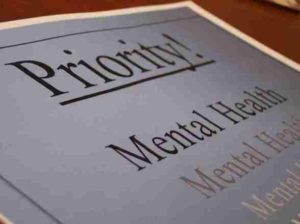 The Substance Abuse and Mental Health Services Administration (SAMHSA) defines co-occurring disorders as the coexistence of both a mental health and substance use disorder in an individual. Nearly 7.9 million adults in the United States have co-occurring mental health and substance use disorders, according to the SAMHSA National Survey on Drug Use and Health. The rate at which co-occurring disorders occur among those with substance use disorders is extremely high.
The Substance Abuse and Mental Health Services Administration (SAMHSA) defines co-occurring disorders as the coexistence of both a mental health and substance use disorder in an individual. Nearly 7.9 million adults in the United States have co-occurring mental health and substance use disorders, according to the SAMHSA National Survey on Drug Use and Health. The rate at which co-occurring disorders occur among those with substance use disorders is extremely high.
Approximately 45 percent of Americans seeking substance use disorder treatment have a co-occurring disorder, according to the National Survey of Substance Abuse Treatment Services. According to the National Institute on Drug Abuse, as many as six out of 10 people addicted to drugs or alcohol have a co-occurring disorder, and of adults with mental illnesses, 18.2 percent have a co-occurring substance use disorder.
Mental disorders frequently associated with substance use disorders include:
- PTSD
- ADHD
- Depression
- Anxiety disorder
- Bipolar disorder
- Schizophrenia
Individuals who have mental illnesses are much more likely than those who do not to develop substance use disorders. Certain mental disorders present unique substance abuse risks as well.
People with mood and anxiety disorders are twice as likely to have a co-occurring substance use disorder, and those with a drug addiction are twice as likely to have a mental disorder, according to the National Institute on Drug Abuse.
Those with mental disorders are also approximately twice as likely to smoke tobacco. Individuals with mental disorders make up 28 percent of the population but smoke 44 percent of total cigarettes in the United States. According to the National Institute on Drug Abuse, 75–95 percent of those with schizophrenia smoke cigarettes.
Co-Occurring Disorder Treatment
Rehab facilities around the country offer specialized care programs geared toward treating co-occurring disorders. These programs incorporate techniques that treat the substance use and mental disorder simultaneously.
According to SAMHSA, the National Institute on Drug Abuse and multiple studies from dozens of scholarly sources, integrated programs that treat both disorders at the same time are proven to have the most effective outcomes for those with the co-occurring disorders.
Co-occurring disorder patients usually begin their treatment program in substance detox to rid their body of the presence of any drugs or alcohol and to help ease withdrawal symptoms. Once patients have completed detox, they can begin treatment.
Cognitive Behavioral Therapy (CBT) — which focuses on exploring the relationship between an individual’s thoughts, emotions and behaviors — is one of the most popular and effective treatment techniques for individuals with co-occurring disorders and for those with substance use disorders alone. CBT helps individuals identify patterns of thought that may cause self-destructive behaviors, such as substance abuse, and develop productive ways of thinking to produce healthier behaviors.
Group therapy is another effective form of treatment for those with co-occurring disorders. Having the support of other individuals experiencing similar issues with mental health and substance abuse can be incredibly beneficial for those with co-occurring disorders. Group therapy can provide a community of likeminded people who thrive off one another’s support and help those individuals work through any co-occurring disorder recovery issues.
About the Author: Trey Dyer is a writer for DrugRehab.com and an advocate for better mental health and substance use disorder treatment in the United States. When Trey is not writing he can be found enjoying Orlando restaurants, traveling and camping.
Sources:
Mueller, M. & Wyman, J. (1997). Study Sheds New Light on the State of Drug Abuse Treatment Nationwide. Retrieved from http://archives.drugabuse.gov/NIDA_Notes/NNVol12N5/Study.html
National Alliance on Mental Illness. (n.d.). Psychotherapy. Retrieved from http://www.nami.org/Learn-More/Treatment/Psychotherapy
National Institute on Drug Abuse. (2010, September). Why do drug use disorders often co-occur with other mental illnesses? Retrieved from https://www.drugabuse.gov/publications/research-reports/comorbidity-addiction-other-mental-illnesses/why-do-drug-use-disorders-often-co-occur-other-men
National Institute on Drug Abuse. (2011, March). DrugFacts – Comorbidity: Addiction and Other Mental Disorders. Retrieved from https://www.drugabuse.gov/publications/drugfacts/comorbidity-addiction-other-mental-disorders
National Institute on Drug Abuse. (2012, December). Comorbidity: Brief Description. Retrieved from https://www.drugabuse.gov/related-topics/comorbidity
Substance Abuse and Mental Health Services Administration. (2005). 5 Strategies for Working With Clients With Co-Occurring Disorders. Retrieved from https://www.ncbi.nlm.nih.gov/books/NBK64179/
Substance Abuse and Mental Health Services Administration. (2015, October 19). Behavioral Health Treatments and Services. Retrieved from http://www.samhsa.gov/treatment#co-occurring
Substance Abuse and Mental Health Services Administration. (2015, September).Behavioral Health Trends in the United States: Results from the 2014 National Survey on Drug Use and Health. Retrieved from http://www.samhsa.gov/data/sites/default/files/NSDUH-FRR1-2014/NSDUH-FRR1-2014.pdf
Substance Abuse and Mental Health Services Administration. (2016, March 8). Co-occurring Disorders. Retrieved from http://www.samhsa.gov/disorders/co-occurring
Volkow, N. (2007, February 1). Addiction and Co-Occurring Mental Disorders. Retrieved from https://www.drugabuse.gov/news-events/nida-notes/2007/02/addiction-co-occurring-mental-disorders

Recent Comments